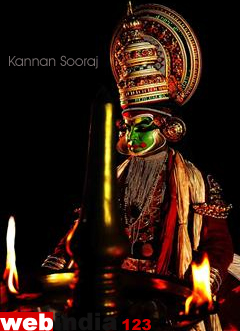Kathakali - Development
 The temple sculpture in Kerala like the frescoes in the Padmanabhaswami and Mattancheri temple provide evidence
of the fact that the basic Kathakali positions employed today were established
by the sixteenth century. Between the seventeenth and nineteenth century, many
momentous changes took place in Kerala. While age-old tribal and rural rituals
and customs continued in forests and lush vegetations. There
was the sophisticated performance in the temple courtyard or special theatres
i.e. Koottambalam. On streets, there was a variety of forms ranging from the
humble Ottanthulal martial displays, to the innumerable types of theatrical
performances connected with annual festivals. By the early part of the twentieth
century, while the ritual dance drama traditions, such as Teyyams, the Bhagavati
cult dances continued, temple dancing and the sophisticated rituals especially
of Kudiyattam, Kathakali, Krishnattam and Ramanattam seen to have shrunk or
at least become fragmented.
The temple sculpture in Kerala like the frescoes in the Padmanabhaswami and Mattancheri temple provide evidence
of the fact that the basic Kathakali positions employed today were established
by the sixteenth century. Between the seventeenth and nineteenth century, many
momentous changes took place in Kerala. While age-old tribal and rural rituals
and customs continued in forests and lush vegetations. There
was the sophisticated performance in the temple courtyard or special theatres
i.e. Koottambalam. On streets, there was a variety of forms ranging from the
humble Ottanthulal martial displays, to the innumerable types of theatrical
performances connected with annual festivals. By the early part of the twentieth
century, while the ritual dance drama traditions, such as Teyyams, the Bhagavati
cult dances continued, temple dancing and the sophisticated rituals especially
of Kudiyattam, Kathakali, Krishnattam and Ramanattam seen to have shrunk or
at least become fragmented.
It was in 1932 that Poet Vallathol
in Kerala began Kerala Kalamandalam which was formally established in 1936.
He gathered the great Gurus, Ramamuni Menon, Kunju Kurup and others, reinstilled
poetry and literature and gave Kathakali the form in which we recognize it today.
Scripts of Kathakali plays written by Unni Warrior and Thampi were employed,
a new format was adopted and in so doing, an ancient art had also been given
a new sensibility.


 The temple sculpture in Kerala like the frescoes in the Padmanabhaswami and Mattancheri temple provide evidence
of the fact that the basic Kathakali positions employed today were established
by the sixteenth century. Between the seventeenth and nineteenth century, many
momentous changes took place in Kerala. While age-old tribal and rural rituals
and customs continued in forests and lush vegetations. There
was the sophisticated performance in the temple courtyard or special theatres
i.e. Koottambalam. On streets, there was a variety of forms ranging from the
humble Ottanthulal martial displays, to the innumerable types of theatrical
performances connected with annual festivals. By the early part of the twentieth
century, while the ritual dance drama traditions, such as Teyyams, the Bhagavati
cult dances continued, temple dancing and the sophisticated rituals especially
of Kudiyattam, Kathakali, Krishnattam and Ramanattam seen to have shrunk or
at least become fragmented.
The temple sculpture in Kerala like the frescoes in the Padmanabhaswami and Mattancheri temple provide evidence
of the fact that the basic Kathakali positions employed today were established
by the sixteenth century. Between the seventeenth and nineteenth century, many
momentous changes took place in Kerala. While age-old tribal and rural rituals
and customs continued in forests and lush vegetations. There
was the sophisticated performance in the temple courtyard or special theatres
i.e. Koottambalam. On streets, there was a variety of forms ranging from the
humble Ottanthulal martial displays, to the innumerable types of theatrical
performances connected with annual festivals. By the early part of the twentieth
century, while the ritual dance drama traditions, such as Teyyams, the Bhagavati
cult dances continued, temple dancing and the sophisticated rituals especially
of Kudiyattam, Kathakali, Krishnattam and Ramanattam seen to have shrunk or
at least become fragmented.